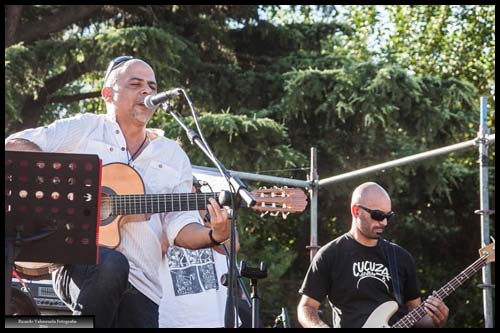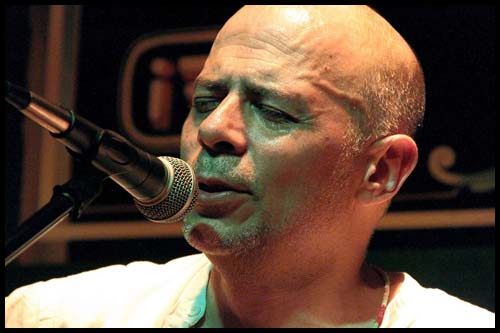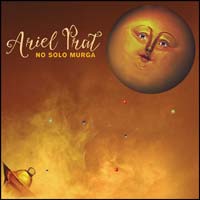By
Interview to Ariel Prat, the Black Minstrel

rgentine singer, musician, composer, poet and interpreter who expresses his musical conception and peculiar style in tango, murga, candombe and rock.
He was born in Buenos Aires, in the neighborhood of Villa Urquiza. Soccer and tango marked his childhood (he played for three years with the fabulous «Cebollitas» of Argentinos Juniors, with Diego Armando Maradona). Maybe because of that his early songs poetically evoke those scents and those remembrances. Suffice it to mention “Al olor del hogar”, a classic by Ariel Prat and “Juan Subirá” popularized by La Bersuit:
Mi casa era un abrazo con aromas,
afuera el mar oleaba en adoquines,
por suerte había chapas que, en la siesta,
hacían que llover no fuera triste...
(My house was a hug with scents,
outdoors the sea waved in cobblestones,
luckily there was a tin roof that, at nap time,
made that raining seemed not sad…)

Ariel Prat is, without a doubt, an example of the porteño song and, at the same time, he crosses it over (with masterful renditions of other figures like Paco Ibañez and Goytisolo). On that heterogeneous and fecund road, Prat has collaborated in recorded releases of popular artists like León Gieco, La Chilinga, Flavio Cianciarulo (bassist and Singer of Los Fabulosos Cadillacs), La Chicana, Juan Carlos Cáceres and with La Bersuit Vergarabat.
With several albums published and a book of poems ‘Curiosidad y azar’, he walks along the roads of music and poetry with the same fervor of always.
1. Sometime ago the composer, plastic artist and researcher Juan Carlos Cáceres passed away in Paris. You, besides having been his friend, paid him a well-deserved homage in Buenos Aires. What is his influence in the tango panorama and what contribution has his oeuvre left?
R: He was and will be one of my music parents and I think that his oeuvre is not yet pondered by the official culture. He has touched an uncomfortable side which is no less than a history denied of an Argentina told by the hegemonic groups, that still today are active and marginalize the negritude of our culture, in general, and of music, in particular. The fact of having transcended into the international level saved him of being entombed by what I call «The formaldehyde sect» (Alejandro Szwarcman dixit). I’m one of Cáceres’ heirs and I´ll hope to honor him through time.

2. As musician, you have been working with candombe, milonga and other genres of the River Plate area since long. What would be the best way of defining the River Plate music from your point of view?
R: I would say it’s a metropolitan music more than music of the Río de la Plata. My oeuvre is mainly nurtured from these banks, although I have noticeable influences of others, of course. I think that my path is, humbly and without intention of establishing comparisons, like the ones of Chico Buarque, Rubén Blades or Sabalero (José Carbajal). I don’t rescue, I only articulate and take from the environment with my own vision and limited capacity, drinking from the so rich spring that my ancestors left either in the rhythmic, poetic, or melodic aspects, Afro-Argentine payadores, different musicians and poets that evolved in tango like milonga in dancing and, especially: discovering that in our murga, the one from this bank, is the missing link between the compadrito (man from the outskirts) and the black man. I do think that in the Río de la Plata there was a unity that with the passing of time broke up into fragments and the roads became parallel but on each bank there was a light of its own, either in what is popular in the streets or what is written in all the possible ways, including the sung ones.
3. What are the mistakes that many broadcasters make when they attempt to label the murga as a genre? Why, being Buenos Aires a power station for the murga movement, do people always turn to Uruguay as an unavoidable reference?
R: There is a great ignorance very well learnt. They ignore the African origin of our murga which only has the name and carnival in common with the other. Our murga comes from the old black comparsa (carnival troupe) which is whitened, like all our society, from late nineteenth century on. On the other hand, it was fundamental that, on the other bank, popular artists regarded Montevidean murga and candombe as a tool to tell their things, when here before the return of democracy it didn’t happen. I was the first one in singing for and from the Murga Argentina regarded as a living thing. There were previous cases which deserve to be praised, but they sang to the «disappeared» murga or were evoking «that» murga they thought was gone as «second-rate» people also thought.

4. You have musicalized great tango poets like Enrique Cadícamo and Julián Centeya. What did that experience bring to you?
R: Wonderful. A voyage through time to meet again the masters who wrote that oeuvre when they were younger than I was when I found them. That is to say that they are still at full strength and aren’t as museum pieces. Julián Centeya, who wrote a portion of his oeuvre dedicated to Afro-Argentinians, was one of the integral artists of my choice and shares a podium with Hugo Del Carril and Leonardo Favio.
5. Besides being a performer and composer, you are a researcher and have several books published. Which do you think is the literary work that’s still missing in the Río de la Plata?
R: A work needs to be completed or to resume that one that links that incipient and chaotic Buenos Aires with the present one, combining elements that today can be found scattered in a metropolitan culture highly nurtured by novelties that sometimes attempt against the sound itself, which truly is waiting to be heard.
6. How would you define Ariel Prat within the wide world of tango, milonga and Argentine candombe?
 R: In the 30’s, the orchestras that paid attention to the call of the period that was to enter the golden era of tango, were known as «Tango Milonga de Corte Moderno». Together with Juan Carlos Cáceres in Paris, commenting this in his ‘Sanatario’ (an atelier today called ‘Tango Negro’) of Montmartre; one afternoon we thought that we were playing ‘Tango milonga de corte murguero’, we laughed at the idea of the definition which was more or less accurate. I would just add that I’m a vehicle between the porteña street and the stage. Maybe, because of that some frequenters of the milieu named me ‘The Minstrel’.
R: In the 30’s, the orchestras that paid attention to the call of the period that was to enter the golden era of tango, were known as «Tango Milonga de Corte Moderno». Together with Juan Carlos Cáceres in Paris, commenting this in his ‘Sanatario’ (an atelier today called ‘Tango Negro’) of Montmartre; one afternoon we thought that we were playing ‘Tango milonga de corte murguero’, we laughed at the idea of the definition which was more or less accurate. I would just add that I’m a vehicle between the porteña street and the stage. Maybe, because of that some frequenters of the milieu named me ‘The Minstrel’.
I’m very proud that either in Europe or in Argentina I’m very often invited to present my talks «Charlas ilustradas: Murga porteña, tango y negritud». Which also include the subject included in the curriculum of the degree in Gestión Cultural of the Universidad Nacional of Avellaneda: ‘Cultura Popular y Carnaval en Buenos Aires’, accompanied by the historian and researcher Leticia Maronese.
With eight albums released, this year Prat presented his first CD, recorded live, 'No solo murga', in which he includes elements of tango, milonga and rock. Recorded live on August 27, 2015, at the Teatro Caras y Caretas. It was produced by himself and here he is accompanied by Hernán Kallis (guitar) Martín Hernández (harmonica) and Alejandro Caraballo (percussion and vocals), and also many guest artists.